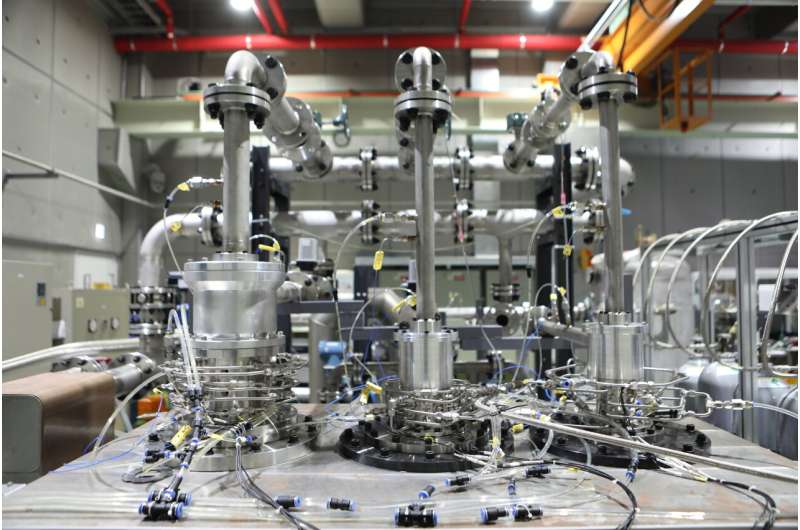
October 15, 2024 by National Research Council of Science and Technology
Collected at: https://techxplore.com/news/2024-10-korean-scientists-cryogenic-turboexpander-capable.html
The technologies for storing alternative energy sources have reached a new milestone with the development of Korea’s first cryogenic turboexpander, capable of cooling gases to temperatures as low as -183°C.
This breakthrough in efficiently storing alternative energy sources like hydrogen and natural gas at ultra-low temperatures has been achieved domestically. It is anticipated to significantly decrease the country’s reliance on foreign technologies in both domestic and international markets for cryogenic cooling systems.
The research team led by Principal Researcher Hyung-Soo Lim of the Department of Energy Storage Systems of the Korea Institute of Machinery and Materials (KIMM), an institute under the jurisdiction of the Ministry of Science and ICT, has succeeded in developing an oil-free cryogenic turboexpander that uses Zero-GWP (Global Warming Potential) refrigerants, and has completed the demonstration testing of an expander used for natural gas liquefaction.
A cryogenic turboexpander is an essential equipment for liquefying and storing alternative energy sources such as hydrogen, natural gas, and air. It works by lowering the temperature through the expansion of high-pressure gas using an impeller. To achieve ultra-low temperatures of -183 degrees Celsius and below for freezing alternative energy sources, the KIMM’s research team independently developed an impeller, an oil-less bearing, an axis, and a casing.
They also secured key technologies for rotation stability, output control, and insulation design. Using this equipment and technology, the KIMM successfully cooled neon, a Zero-GWP refrigerant, to temperatures below -183 degrees Celsius under room temperature conditions.
 Principal Researcher Hyung-Soo Lim of the KIMM’s Department of Energy Storage Systems (left) is giving an explanation of the cryogenic turboexpander for air liquefaction. Credit: Korea Institute of Machinery and Materials (KIMM)
Principal Researcher Hyung-Soo Lim of the KIMM’s Department of Energy Storage Systems (left) is giving an explanation of the cryogenic turboexpander for air liquefaction. Credit: Korea Institute of Machinery and Materials (KIMM) The research team of the KIMM’s Department of Energy Storage Systems, developer of a cryogenic turboexpander capable of cooling gases to temperatures as low as -183 degrees Celsius (from the right, Principal Researcher Hyung-Soo Lim, Principal Researcher Jeong-Min Seo, and Senior Technician Young-Cheol Lim. Credit: Korea Institute of Machinery and Materials (KIMM)
The research team of the KIMM’s Department of Energy Storage Systems, developer of a cryogenic turboexpander capable of cooling gases to temperatures as low as -183 degrees Celsius (from the right, Principal Researcher Hyung-Soo Lim, Principal Researcher Jeong-Min Seo, and Senior Technician Young-Cheol Lim. Credit: Korea Institute of Machinery and Materials (KIMM)
Previously, cryogenic turboexpanders, which can rotate from tens to hundreds of thousands of times per minute, were largely imported from foreign countries. The latest technological advancements by KIMM have now opened up opportunities for domestic production of cryogenic turboexpanders.
To extend the application of these expanders to a broader range of alternative energy sources, an expander capable of cooling gases below -163 degrees Celsius— the limit of conventional expanders—was required. The expander developed by KIMM’s research team can refrigerate gases to temperatures below -183 degrees Celsius.
Previously, existing expanders used a lubrication method that required oil to be supplied to the bearing, necessitating a separate oil supply unit and resulting in a highly complex structure. In contrast, KIMM’s newly developed expander employs an oil-free method, allowing for simpler structures and smaller sizes.
Utilizing this innovative technology, the KIMM’s research team successfully developed expanders for liquefying hydrogen, natural gas, and air. Notably, the expander for natural gas liquefaction has a refrigeration capacity of 7 to 10 kW at -183 degrees Celsius. The KIMM is currently working on commercializing this expander in partnership with a private company.
Principal Researcher Hyung-Soo Lim of the KIMM said, “Storing alternative energy sources like hydrogen in liquid state at ultra-low temperatures can help to substantially increase energy density, which makes it possible to dramatically reduce the size of storage facilities.”
Principal Researcher Lim added, “By developing the core technology for cryogenic turboexpanders, we hope to be able to domestically manufacture storage systems for alternative energy sources and contribute to the tackling of climate change.”

Leave a Reply